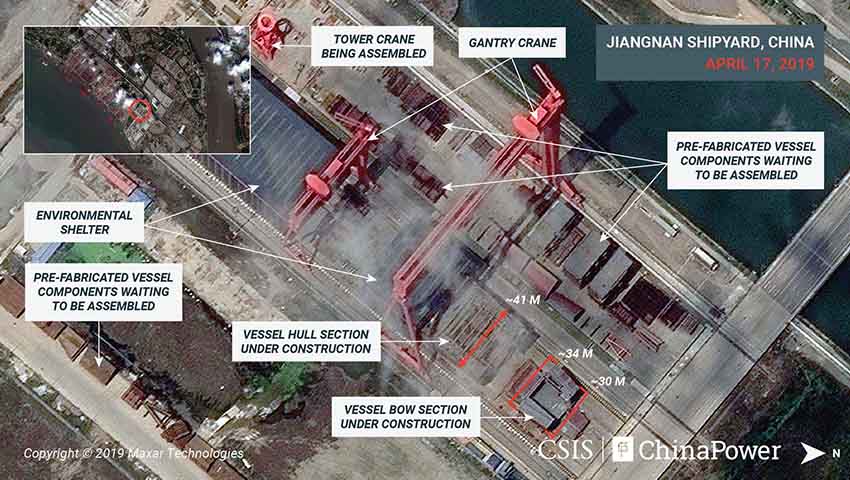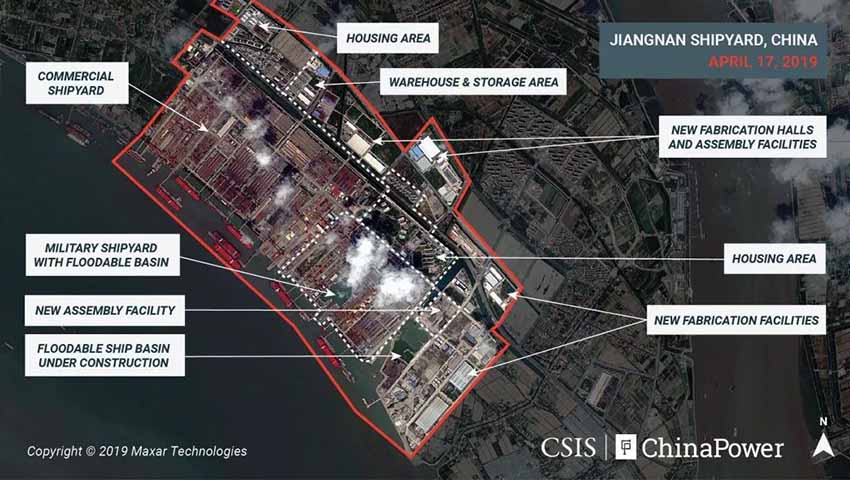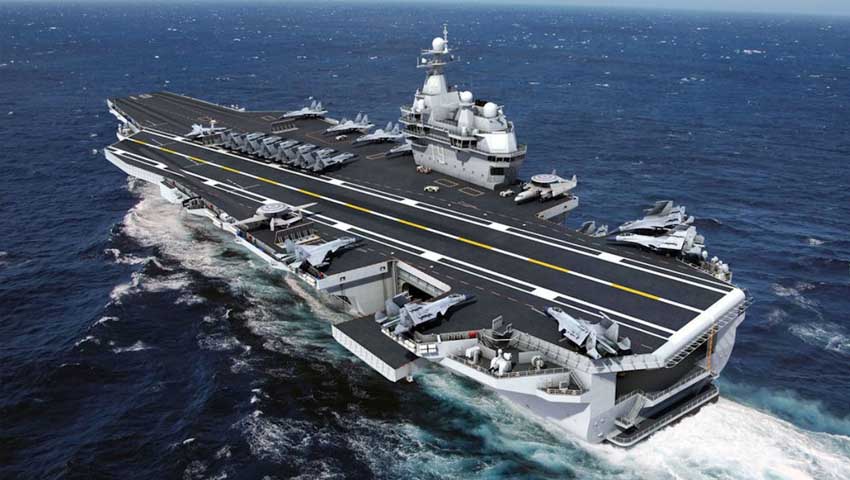China’s pursuit of a credible blue water naval capability is taking a step closer to reality with new imagery revealing steady progress on the next-generation Type 002 conventional aircraft carrier at the Jiangnan Shipyard at the mouth of the Yangtze River.
To continue reading the rest of this article, please log in.
Create free account to get unlimited news articles and more!
Aircraft carriers emerged from the Second World War as the pinnacle of maritime prestige and power projection. However, unlike their predecessor the battleship, aircraft carriers are in themselves relatively benign actors, relying heavily a their attached carrier air-wings and supporting escort fleets of cruisers, destroyers and submarines to screen them from hostile action.
Both the US and China continue to invest heavily in the potent power projection capabilities provided by aircraft carriers and large-deck amphibious warfare ships. While the US enjoys a substantial quantitative and qualitative lead over the Chinese People's Liberation Army - Navy (PLA-N), with a fleet of 11 nuclear powered supercarriers and two currently under construction, China's strategic planners know that they don't need to exercise global maritime hegemony in the way the US does.
In recent years, Indo-Pacific Asia has seen a growing number of traditional aircraft carriers and large deck, amphibious warfare ships being used to secure sea-lines-of-communication and maritime borders, while acting as potent power projection platforms through the use of amphibious operations and marine units, with China's ambitions of developing a truly blue water navy driving the growth.
Carriers and their supporting strike groups enable nations to protect strategic sea-lines-of-communication, which support over 90 per cent of global trade, a result of the cost effective and reliable nature of sea transport.
Indo-Pacific Asia is at the epicentre of the global maritime trade, with about US$5 trillion worth of trade flowing through the South China Sea (SCS) and the strategic waterways and choke points of south-east Asia annually. Meanwhile, the Indian Ocean and its critical global sea-lines-of-communication, are responsible for more than 80 per cent of the world's seaborne trade in critical energy supplies, namely oil and natural gas, which serve as the lifeblood of any advanced economy.
As a result, the PLA-N has focused its attention on building an aircraft carrier force focused on establishing and maintaining control of the vital sea-lines-of-communication in the Indian and Pacific Oceans, while also leveraging the powerful defensive anti-access/area denial networks provided by the vast network of reclaimed islands in the SCS.
Liaoning and China's existing carrier fleet
China is the relative newcomer to the regional flat top race but is rapidly establishing itself as a regional carrier super power, with the recent introduction of the Type 001 and Type 001A Class carriers, based heavily upon the Russian Kuznetsov Class aircraft carriers.
Liaoning (CV-16), the first Chinese carrier (Type 001), was commissioned in 2012 and provides a potent, 58,600-tonne, 304.5-metre platform capable of supporting an airwing of 40 fixed and rotary-wing aircraft, including the Shenyang J-15, a Chinese variant of the Russian designed Su-33 Flanker D and a limited fleet of domestic anti-submarine warfare, maritime patrol, airborne command and control support helicopters.
In contrast, CV-17, the second Chinese carrier commissioned earlier this year and an enlarged variant of the Liaoning, is a 70,000-tonne, 315-metre vessel with a similar airwing capacity of 40 fixed and rotary-wing aircraft. Both vessels use short take-off, but arrested recovery (STOBAR) ski-ramp configurations, which limit the offensive and defensive capabilities of the platform.
Recognising the limitation of these platforms, China has plans to field an expanded carrier force incorporating a fleet of large, conventionally powered catapult assisted take-off but arrested recovery (CATOBAR) aircraft carriers – to be designated the Type 002 – the vessels are expected to be complemented by a large fleet of up to four nuclear-powered supercarriers expected to be similar in size and capability to the US Nimitiz and Ford Class carriers, supporting an airwing of between 70 and 100 fixed and rotary-wing aircraft that would serve as the mainstay of the Chinese naval force, focused on Chinese power projection and resource security.
Type 002 and the shift towards true power projection carriers
China's carrier ambitions are not limited to these two platforms, with increasingly capable aircraft carrier designs currently in varying stages of design or construction. The Type 002 carrier, expected to be commissioned in 2023, will be a traditional, CATOBAR-based vessel, weighing in at 80-85,000 tonnes.
Recently acquired commercial satellite imagery sourced by the Centre for Strategic and International Studies (CSIS) has revealed major progress at the Shanghai-based Jiangnan Shipyard – following construction commencing in 2017. Imagery sourced from CSIS reveals construction progress on the bow and main hull section of the ship.
The imagery comes following confirmation by Chinese state media agency Xinhua of construction commencing on the vessel. While details regarding the Type 002 are limited – what is observable at the shipyard is consistent with what is expected of the next-generation aircraft carrier. CSIS analysis identifies: "The bow section measures approximately 22.5 metres long and it tapers from a width of approximately 34 metres down to approximately 30 metres ... the hull section has an overall length of approximately 48 metres."

This progress is in line with timeline targets for the Chinese aircraft carrier program, with plans for the ship to be launched in 2020 and the vessel expected to enter active service in 2023, marking a major turning point in the capability of the PLA-N. The Type 002 is expected to incorporate a range of advancements over the Liaoning and CV-17 vessels, including an electro-magnetic aircraft launch system (EMALS) similar to the system expected to be introduced on the US Ford Class carriers.
Incorporating the next-generation launch system will enable the carriers to launch and recover a range of advanced aircraft – including advanced, fixed-wing airborne early warning and control aircraft and an increased carrier air wing and an advanced ship-borne active electronically scanned array (AESA) radar system to integrate within the supporting carrier strike group.
The next evolution of China's carrier force provides a launching point for the nuclear-powered Type 003 aircraft carrier. Currently understood to be in the design phase, the Type 003 will serve as the basis of China's power projection focused aircraft carrier force and is expected to be constructed at the Jiangnan Shipyard, which is currently undergoing a series of modernisation and expansion programs to accommodate an increase in the Chinese carrier fleet.
CSIS imagery reveals a range of infrastructure development at the military sector of the shipyard. The military shipyard is a 1.4-square-kilometre subsection of the larger commercial shipyard, which is incorporating a range of dry docks, slipways and fitting out areas for a range of military vessels – including aircraft carriers, guided missile destroyers, cruisers and frigates.

Additionally, serving a similar role to America's large deck, amphibious warfare ships, China is responding with the construction of three Type 075 landing helicopter docks, weighing in at 40,000 tonnes, placing them in the same category as the US Wasp Class vessels. It is anticipated that these vessels will accommodate up to 30 helicopters and be capable of supporting amphibious landings through the use of advanced command and control facilities.
Both fixed-wing naval aviation and amphibious capabilities are key force multipliers reshaping the region. The growing prevalence of fixed-wing naval aviation forces, particularly, serves to alter the strategic calculus and balance of power. Let us know your thoughts in the comments section below, or get in touch with
Stephen Kuper
Steve has an extensive career across government, defence industry and advocacy, having previously worked for cabinet ministers at both Federal and State levels.

 Login
Login








